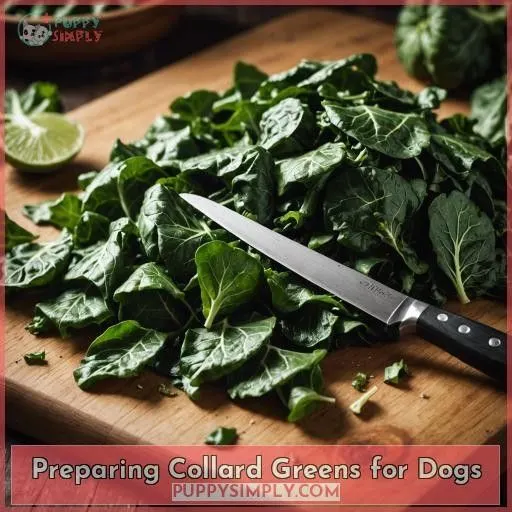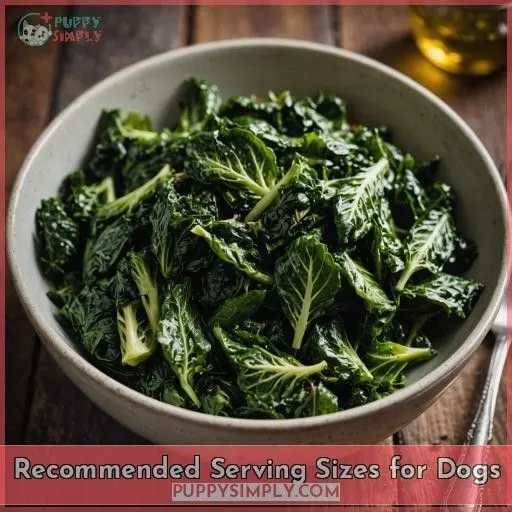This site is supported by our readers. We may earn a commission, at no cost to you, if you purchase through links.

These leafy greens are rich in fiber, vitamins A, C, and K, and antioxidants that support digestive health and may reduce inflammation.
However, excessive consumption can lead to bladder stones.
Introduce collard greens gradually and remove tough stems before serving.
Consult your vet for personalized portion guidance based on your dog’s size.
Cook the greens until soft, and combine them with other foods for a balanced diet.
While beneficial, keep an eye out for signs of digestive upset, as some pups may have sensitivities.
For more insight into safely incorporating this nutritious vegetable…
Table Of Contents
- Key Takeaways
- Are Collard Greens Safe for Dogs?
- Health Benefits of Collard Greens for Dogs
- Preparing Collard Greens for Dogs
- Risks of Feeding Collard Greens to Dogs
- Recommended Serving Sizes for Dogs
- Consulting a Veterinarian
- Combining Collard Greens With Other Foods
- Potential Concerns With Collard Greens
- Nutritional Value of Collard Greens for Dogs
- General Considerations for Feeding Collard Greens to Dogs
- Frequently Asked Questions (FAQs)
- Conclusion
Key Takeaways
- Collard greens can be a nutritious addition to a dog’s diet in moderation, providing fiber, vitamins, and antioxidants.
- Excessive consumption of collard greens can lead to potential issues like bladder stones and digestive upset, so portion control is crucial.
- Proper preparation, such as cooking the greens until soft and removing tough stems, is important to prevent choking hazards.
- Consulting a veterinarian is recommended before introducing collard greens or any new food to a dog’s diet, as individual dietary needs and sensitivities may vary.
Are Collard Greens Safe for Dogs?
Collard greens can be a nutritious addition to your dog’s diet in moderation.
These leafy greens are packed with goodness that can support your canine’s digestive health.
However, you’ll want to steer clear of feeding raw collard greens, as the high fiber content could cause some tummy troubles.
Instead, opt for cooked collard greens as a tasty, dog-friendly alternative.
Be sure to remove any tough stems before serving, as they can pose a choking hazard.
With the right preparation, collard greens can be a great way to introduce some extra vitamins and minerals into your pup’s balanced diet.
Remember to consult your vet before making any significant changes.
Health Benefits of Collard Greens for Dogs
Collard greens pack a nutritional punch that can benefit your canine companion.
These leafy greens are rich in fiber, which aids digestion and keeps your pup’s bowels regular.
Plus, they’re brimming with essential vitamins like A, C, and K, as well as important minerals.
The antioxidants in collard greens may even help lower cholesterol levels and support heart health.
However, it’s essential to monitor your dog’s intake, as the high fiber content and compounds like calcium oxalate can potentially cause issues like bladder stones if consumed in excess.
As with any new food, start with small amounts and watch for any adverse reactions.
With the right precautions, collard greens can be a healthy addition to your dog’s diet.
Preparing Collard Greens for Dogs
When preparing collard greens for your dog, it’s essential to steer clear of canned varieties due to potential additives and preservatives that could be detrimental. Before serving, diligently remove the tough stems, as they can present a choking hazard, and cook the collard greens until they’re soft, portioning them appropriately based on your dog’s size and dietary requirements.
Avoid Canned Collard Greens Due to Potential Additives
While fresh or frozen collard greens are a healthy option for your pup, steer clear of canned varieties. Canned collard greens often contain unhealthy additives like sodium and preservatives that can upset your dog’s stomach. For a safer, more nutritious treat, opt for cooked collard greens without any seasonings or stems.
Remove Stems Before Serving to Prevent Choking Hazards
Before giving collard greens to your dog, make sure to remove the hard stems. These can be a choking hazard and may cause stomach problems if swallowed. To prepare, just wash the leaves, cut them into small pieces, and throw away the stems. This will help make sure your dog can enjoy the healthy benefits of collard greens safely.
Cook Collard Greens and Portion Appropriately
To prepare collard greens for your pup, start by washing and chopping the leaves into bite-sized pieces. Steam the greens until tender, then let them cool. Avoid seasoning with salt, onions, or garlic. Portion out a small handful per day and mix into your dog’s regular food. Freeze any leftovers for later use.
| Preparation Method | Benefits | Considerations |
|---|---|---|
| Steaming | Softens collard greens | Avoid overcooking |
| Chopping | Prevents choking hazards | Cut into small pieces |
| Portioning | Controlled daily intake | Limit to a small handful |
| Freezing | Extends shelf life | Thaw before serving |
Risks of Feeding Collard Greens to Dogs
While collard greens can be a nutritious addition to your dog’s diet, it’s imperative to bear in mind that overindulgence may result in bladder stones. Furthermore, offering excessive amounts of collard greens could potentially lead to stomach upset in your pup, causing digestive distress.
Excessive Consumption Can Lead to Bladder Stones
While collard greens offer impressive nutritional benefits, their high oxalate content can pose a risk for dogs prone to bladder stones. Excessive consumption may trigger an allergic reaction or digestive upset. To keep your pup safe, stick to small, veterinarian-approved serving sizes and monitor closely for any adverse reactions. Your dog’s bladder health is top priority.
Large Quantities May Upset a Dog’s Stomach
While collard greens offer impressive nutritional value, large quantities can upset your pup’s stomach. Moderation is key – stick to small servings to avoid digestive troubles. Always consult your veterinarian before introducing new foods, as some ingredients like stems may pose toxicity risks. With the right approach, you can safely impart the leafy benefits for your canine companion.
Recommended Serving Sizes for Dogs
Regarding the nutritional care of your canine companion with collard greens, portion control is paramount. The appropriate serving size for dogs varies based on their size and weight. As a general guideline:
- Small dogs (under 20 lbs): 1-2 tablespoons of cooked collard greens daily
- Medium dogs (20-50 lbs): 2-4 tablespoons of cooked collard greens daily
- Large dogs (over 50 lbs): 4-6 tablespoons of cooked collard greens daily
Consulting a Veterinarian
| Before introducing collard greens or any new food into your dog’s diet, it’s vital to seek advice from your veterinarian. They can provide tailored guidance on your pup’s nutritional requirements and any possible negative reactions. | Reason to Consult Vet | Potential Risks | Dietary Recommendations |
|---|---|---|---|
| Digestive issues | Stomach upset, diarrhea | Introduce new foods gradually, monitor for reactions | |
| Existing health conditions | Bladder/kidney stones | Steer clear of high-oxalate foods like collard greens | |
| Nutritional requirements | Nutrient imbalances | Guarantee a balanced, species-appropriate diet | |
| Allergies or sensitivities | Allergic reactions | Pinpoint and avoid trigger foods |
Your vet can assist you in determining the suitable portion size and frequency for collard greens based on your dog’s dimensions, age, and general health. Their expert advice is essential in maintaining your furry companion happy and healthy.
Combining Collard Greens With Other Foods
When adding collard greens to your dog’s diet, it’s crucial to reflect on how they harmonize with other foods. Collard greens can be a nourishing supplement, but they shouldn’t dominate your pup’s meals.
To uphold a balanced diet, you can:
- Blend chopped collard greens into your dog’s regular food, targeting no more than 10-20% of the total meal.
- Pair collard greens with other vegetables like carrots or sweet potatoes to provide a medley of vitamins and minerals.
- Fortify your dog’s diet with a premium commercial dog food to guarantee they’re receiving all the vital nutrients they require.
Potential Concerns With Collard Greens
While collard greens are generally safe for dogs in moderation, there are a few potential concerns to keep in mind.
These leafy greens contain compounds like isothiocyanates and calcium oxalate, which can contribute to the formation of bladder and kidney stones in dogs prone to such issues. If your dog has a history of these problems, it’s best to steer clear of collard greens altogether.
Additionally, large quantities of collard greens may upset your dog’s stomach, leading to digestive issues.
To be on the safe side, start with small servings and monitor your canine companion closely for any adverse reactions.
Consult your veterinarian before introducing new foods to your dog’s diet.
Nutritional Value of Collard Greens for Dogs
Collard greens pack a nutritional punch that can benefit your canine companion. These leafy greens are rich in essential vitamins and minerals, making them a superfood for dogs. Their high fiber content aids digestion, helping to keep your pup’s bowels regular. Additionally, collard greens contain:
- Vitamins A, C, and K, which support eye health, immune function, and blood clotting, respectively.
- Folate and riboflavin, which contribute to energy production and red blood cell formation.
- Antioxidants that help neutralize harmful free radicals and reduce inflammation.
However, the calcium oxalate in collard greens can pose a risk for dogs prone to kidney or bladder stones. As with any new food, introduce collard greens gradually and in moderation to make sure your pup’s digestive system can handle them.
General Considerations for Feeding Collard Greens to Dogs
Regarding feeding your pup collard greens, it’s crucial to exercise caution and moderation. While these leafy greens offer some nutritional benefits, such as fiber and vitamins, they also present potential risks if not prepared and portioned appropriately.
Always start by removing the tough stems, as they can pose a choking hazard. Then, lightly steam or cook the collards to soften them before serving. Portion sizes should be small, no more than a handful per day, and gradually introduce them to your dog’s diet to monitor for any digestive upset.
Consult your veterinarian before adding collard greens or any new human food to your dog’s meals. They can provide personalized guidance on the appropriate way to incorporate these greens into your pup’s balanced diet.
Frequently Asked Questions (FAQs)
Can dogs eat raw collard greens?
Let’s put the matter delicately – while collard greens are nutritious, it’s best to avoid feeding your furry friend raw versions due to potential digestive distress. Cooked and served in moderation, however, these leafy greens can be a healthy treat.
How often can dogs have collard greens?
You can give your pup a small portion of cooked collard greens a few times a week as an occasional treat. But moderation is key – too much can upset their tummy or lead to other issues. Always check with your vet first.
Do collard greens cause diarrhea in dogs?
While collard greens are generally safe for dogs, yes, they can potentially cause diarrhea if overfed. Start with small portions and monitor your pup’s reaction to avoid digestive upset.
Can collard greens help dogs lose weight?
While collard greens aren’t high in calories, they likely won’t directly aid weight loss for your pup. Focus on portion control, increased activity, and vet-approved weight management strategies instead.
Are collard greens good for a dogs skin?
Painting a vivid picture, collard greens’ nutrient-rich leaves can enhance your pup’s coat for a brilliant glow. However, moderation is essential as overconsumption may cause skin problems or digestive issues. Seek advice from your veterinarian for specific recommendations.
Conclusion
Ready to impart the verdant advantages of collard greens to your canine companion?
While these nutritionally abundant greens can enhance your dog’s well-being, moderation is paramount.
Seek guidance from your veterinarian regarding suitable serving portions.
Be vigilant for potential digestive concerns when introducing collard greens.
Appropriately prepared, collard greens can serve as a nourishing complement to your dog’s balanced diet, supplying an abundance of fiber, vitamins, and antioxidants.
















